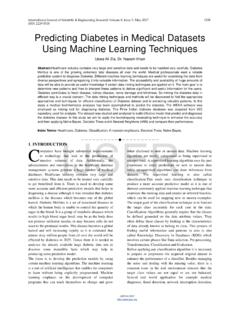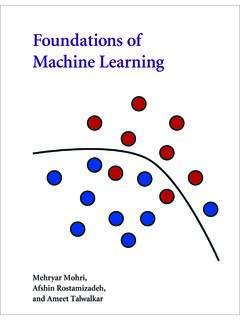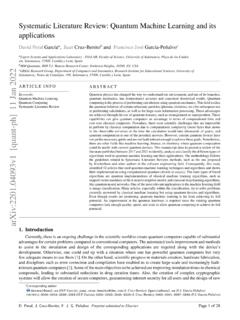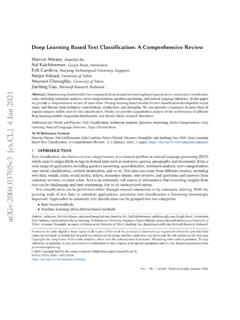Transcription of SCHEME & SYLLABUS FOR PROGRAM M.TECH CYBER SECURITY
1 Page 1 of 46 SCHEME & SYLLABUS FOR PROGRAM CYBER SECURITY Page 2 of 46 SCHEME Department of Computer Engineering, NIT Kurukshetra (Haryana) Proposed SCHEME for the Computer Engineering ( CYBER SECURITY ) Sr. No. Code Course Title Teaching Schedule Credit L T P Total First Semester 1. COE-501 Advanced Data Structures and Algorithms 3 0 0 3 3 2. COE-551 System and Network SECURITY 3 0 0 3 3 3. COE-553 Data Privacy 3 0 0 3 3 4. Elective-1 3 0 0 3 3 5. Elective -2 3 0 0 3 3 6. COE-561 System and Network SECURITY Laboratory 0 0 2 2 1 7. COE-563 Data Privacy Laboratory 0 0 2 2 1 8. COE-565 Seminar 0 0 2 2 1 Total 21 18 Second Semester 1. COE-552 Number Theory and Cryptology 3 0 0 3 3 2. COE-554 Introduction to Cyberspace Operations and Design 3 0 0 3 3 3. Elective-3 3 0 0 3 3 4. Elective-4 3 0 0 3 3 5.
2 Elective-5 3 0 0 3 3 6. COE-562 Number Theory and Cryptology Laboratory 0 0 2 2 1 7. COE-564 Elective-3 Laboratory 0 0 2 2 1 8. COE-566 Seminar 0 2 0 2 1 Total 21 18 Third Semester 1. COE-611 Preparatory Work for Dissertation 0 0 20 20 10 Total 20 10 Fourth Semester 1. COE-612 Dissertation 0 0 32 32 16 Total 32 16 Page 3 of 46 List of Elective Courses Elective-1 Elective-2 Elective-3 Elective-4 Elective-5 Code Course Title Code Course Title Code Course Title Code Course Title Code Course Title COE-525 Pattern Recognition and machine learning COE-531 Distributed Computing COE-524 Soft Computing COE-582 SCADA and DCS SECURITY COE-536 Research Methodology COE-571 Intrusion Detection Systems COE-581 System & Device Driver Programming COE-572 Biometric SECURITY COE-584 Ethics and Law of CYBER SECURITY COE-538 Mobile Computing COE-573 Information Theory and Coding COE-583 Information Warfare COE-574 Information SECURITY Risk Management COE-586 Fuzzing and Software Crash Analysis COE-594 Ethical
3 Hacking COE-575 Cloud Computing and Big Data COE-585 Mobile and Wireless Network SECURITY COE-576 Proactive SECURITY Tools and Techniques COE-588 Advanced Operating System Design and SECURITY COE-596 Digital Forensics & Incident Response COE-577 Vulnerability Discovery and Exploit Development COE-587 Secure Coding COE-578 Social Network Analysis COE-590 BIOS and SMM SECURITY COE-598 Data Mining and Analysis COE-579 Game Theory COE-589 Special Topics in SECURITY -I COE-580 Enterprise SECURITY & Management COE-592 Disaster Recovery COE-600 Special Topics in SECURITY -II Page 4 of 46 SYLLABI COE-501 Advanced Data Structures and Algorithms Objectives: To develop the understanding of advanced data structures and algorithms. learning Outcomes:- On completion of this course students should have gained an understanding of algorithmic / data structure language and notation, including order notation, and how to calculate the running times of algorithms.
4 Students should also understand how to estimate, profile, and measure algorithm complexity and performance. The Key learning Outcomes are: Compare, contrast, and apply the key algorithmic design paradigms: brute force, divide and conquer, decrease and conquer, transform and conquer, greedy, dynamic. Compare, contrast, and apply key data structures: trees, lists, stacks, queues, hash tables, and graph representations. Define, compare, analyze, and solve general algorithmic problem types: sorting, searching, string processing, graphs, and geometric. Compare, contrast, and apply algorithmic tradeoffs: time vs. space, deterministic vs. randomized, and exact vs. approximate. Implement, empirically compare, and apply fundamental algorithms and data structures to real-world problems.
5 SYLLABUS : Complexity of algorithms: worst case, average case, and amortized complexity. Algorithm analysis techniques, Amortized Analysis, Garbage collection, Analysis of Quick sort, Fibonacci Heaps, van Emde Boas Trees, Multithreaded Algorithms, Number Theoretic Algorithms, Strings and String Matching Algorithms, Computational Geometry, Lower Bound Theory NP Completeness, Approximation Algorithms. Text books: 1. Anne Benoit, Yves Robert, Fr d ric Vivien. A Guide to Algorithm Design: Paradigms, Methods, and Complexity Analysis, Taylor & Francis, 2013. 2. OdedGoldreich. P, NP, and NP-Completeness: The Basics of Computational Complexity, Cambridge University Press, 2010. Page 5 of 46 Reference books: 1. Aho, Hopcroft, and Ullman, Data Structures and Algorithms, Addison Wesley, Reading Massachusetts, USA, 1983.
6 2. Donald Knuth. The Art of Computer Programming: Fundamental Algorithms, Third Edition. Addison-Wesley, 1997. 3. Donald Knuth. The Art of Computer Programming Volume 3: Sorting and Searching, Third Edition. Addison-Wesley, 1997. ISBN 0-201-89685-0. 4. Thomas H. Cormen, Charles E. Leiserson, Ronald L. Rivest, and Clifford Stein. Introduction to Algorithms, Third Edition. MIT Press and PHI, 2010. 5. Samet, Hanan, Foundations of multidimensional and metric data structures. Morgan Kaufmann, 2006, ISBN 978-0-12-369446-1. 6. Dinesh Mehta and SartajSahni Handbook of Data Structures and Applications, Chapman and Hall/CRC Press, 2007. 7. Weiss, Data Structures and Algorithms Analysis in C++, Benjamin/Cummins, Redwood City, California, USA, 1994. COE-551 System and Network SECURITY Objectives: The purpose of this course is to provide understanding of the main issues related to SECURITY in modern networked computer systems.
7 This covers underlying concepts and foundations of computer SECURITY , basic knowledge about SECURITY -relevant decisions in designing IT infrastructures, techniques to secure complex systems and practical skills in managing a range of systems, from personal laptop to large-scale infrastructures. learning Outcomes: On completion of this course, students should have gained a good understanding of the concepts and foundations of computer SECURITY , and identify vulnerabilities of IT systems. The students can use basic SECURITY tools to enhance system SECURITY and can develop basic SECURITY enhancements in stand-alone applications. SYLLABUS : Computer SECURITY Concepts- Introduction to Information SECURITY , Introduction to Data and Network SECURITY , Integrity, and Availability, NIST FIPS 199 Standard, Assets and Threat Models, Examples Page 6 of 46 Control Hijacking Attacks and defenses, Buffer overflow and control hijacking attacks Exploitation techniques and fuzzing- Finding vulnerabilities and exploits Dealing with Legacy code- Dealing with bad (legacy) application code: Sandboxing and Isolation.
8 Least privilege, access control, operating system SECURITY - The principle of least privilege, Access control concepts, Operating system mechanisms, Unix, Windows, Qmail, Chromium, and Android examples. Basic web SECURITY model- Browser content, Document object model (DOM), Same-origin policy. Web Application SECURITY - SQL injection, Cross-site request forgery, Cross-site scripting, Attacks and Defenses, Generating and storing session tokens, Authenticating users, The SSL protocol, The lock icon, User interface attacks, Pretty Good Privacy. Network Protocols and Vulnerabilities- Overview of basic networking infrastructure and network protocols, IP, TCP, Routing protocols, DNS. Network Defenses- Network defense tools, Secure protocols, Firewalls, VPNs, Tor, I2P, Intrusion Detection and filters, Host-Based IDS vs Network-Based IDS, Dealing with unwanted traffic: Denial of service attacks.
9 Malicious Software and Software SECURITY - Malicious Web, Internet SECURITY Issues, Types of Internet SECURITY Issues, Computer viruses, Spyware, Key-Loggers, Secure Coding, Electronic and Information Warfare. Mobile platform SECURITY models- Android, iOSMobile platform SECURITY models, Detecting Android malware in Android markets. SECURITY Risk Management- How Much SECURITY Do You Really Need, Risk Management, Information SECURITY Risk Assessment: Introduction, Information SECURITY Risk Assessment: Case Studies, Risk Assessment in Practice. The Trusted Computing Architecture- Introduction to Trusted Computing, TPM Provisioning, Exact Mechanics of TPM. Text books and References: 1. William Stallings, Network SECURITY Essentials: Applications and Standards, Prentice Hall, 4th edition, 2010.
10 2. Michael T. Goodrich and Roberto Tamassia, Introduction to Computer SECURITY , Addison Wesley, 2011. 3. William Stallings, Network SECURITY Essentials: Applications and Standards, Prentice Hall, 4th edition, 2010. 4. Alfred J. Menezes, Paul C. van Oorschot and Scott A. Vanstone, Handbook of Applied Cryptography, CRC Press, 2001. COE-553 Page 7 of 46 Data Privacy Course objectives: The objective of this course is to create architectural, algorithmic and technological foundations for the maintenance of the privacy of individuals, the confidentiality of organizations, and the protection of sensitive information, despite the requirement that information be released publicly or semi-publicly. learning outcomes: After successful completion of this course, students will be able to: Understand the concepts of privacy in today s environment.



